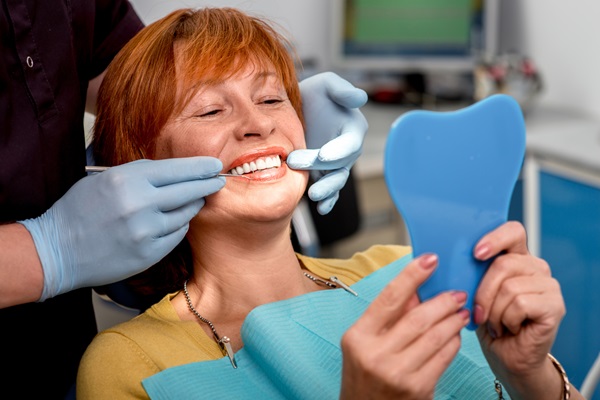What Is the Dental Restoration Process for Veneers?

Dental restorations are a great way to improve oral health and the way the smile appears. One of the most common dental restoration options is dental veneer placement. According to WebMD, dental veneers are routinely used to fix teeth that are discolored, worn down, chipped, misaligned and even severely gapped, all of which classify as a dental restoration.
About dental restorations
Dental restoration options include direct and indirect restorations, with the difference being direct options are performed in the patient’s mouth and indirect options are created outside of the mouth and then placed in the mouth. A direct restoration example is a dental filling. An indirect restoration example would be dental veneers.
How veneers are placed
According to the American Dental Association, dental veneers are thin coverings that are placed over the front (visible) part of the tooth. They look like natural teeth and can be used to correct a wide range of dental issues. There is a total of five steps that make up the veneer placement process, all of which are typically completed in two dentist appointments.
Step #1 – Preparing the teeth. The first step in the veneer placement process is having a dental professional prepare the teeth. This requires them to remove a small amount of the tooth's enamel, which is often taken from the front as well as the sides of the teeth. This removal of enamel not only allows the veneers to properly stay on the tooth, but it also makes the necessary room so that the veneers will look completely natural.
Step #2 – Making an impression. The dental professional will then take an impression of the patient's teeth, as this allows the veneers to be custom made for them. Being custom made is important, as this allows for the most natural look, which is what patients are looking for.
Step #3 – Creating the veneers. The impression is sent to an outside laboratory so they can make the dental veneers for the patient. While this part of the process tends to take only a few days to complete, it is possible for it to take up to a couple of weeks. In the meantime, dental patients can wear temporary dental veneers until their permanent ones are completed.
Step #4 – Placement of the veneers. Once the veneers are completed, the patient will come in for their second dental visit in order to have the veneers placed on their teeth. The dentist will carefully place the veneers on the patient's teeth, making sure that the fit and shape is exactly how it is supposed to be. After any adjustments have been figured out, the patient will undergo a cleaning and then have the veneers bonded to their teeth.
Step #5 – Final adjustments. The fifth and last step of the placing dental veneers process includes making any further adjustments. While not everyone who undergoes this dental restoration process will need additional adjustments, some will. If adjustments are not necessary, the dental restoration will be complete.
Get started with a dental restoration today!
A common dental restoration option is dental veneers, as they can cover up and repair many different types of dental problems. Now that the above information has been read, those who are in need of one or more dental restorations can decide whether or not dental veneers are right for them. Any questions for our dental team? Reach out today to learn more or to get started!
Request an appointment here: https://rsndental.com or call RSN Dental PC at (347) 344-5806 for an appointment in our Staten Island office.
Check out what others are saying about our dental services on Yelp: Dental Restorations in Staten Island, NY.
Recent Posts
The term dental restoration refers to a number of procedures used to repair or restore function and aesthetics to teeth that are in bad shape, whether it be due to cavities, imperfections, or abnormalities. Modern-day dentistry has allowed for the evolution of many different types of dental restorations, including dental fillings, which are typically the…
If you have been involved in an auto accident, you may be considering the right types of dental restoration. The dental damage you may have suffered can be either indirect or direct. Indirect damage occurs when your mouth closes abruptly, while direct damage occurs when the mouth itself is hit. No matter what type of…
If you have dental issues that have made you less confident in your smile, you should consider consulting with a restorative dentist. The dentist will evaluate your smile and let you know how to restore the look of your teeth and, ultimately, your confidence in your smile. Continue reading to find out what restorative dental…
Looking into your restorative dentistry options? Teeth grinding (also known as bruxism) is common, affecting many people worldwide. This condition can lead to issues such as chipped teeth, cracked teeth, chronic headaches, TMJ disorder, and trouble sleeping. When tooth damage occurs as a result of teeth grinding, restorative dentistry is necessary to repair the areas…


